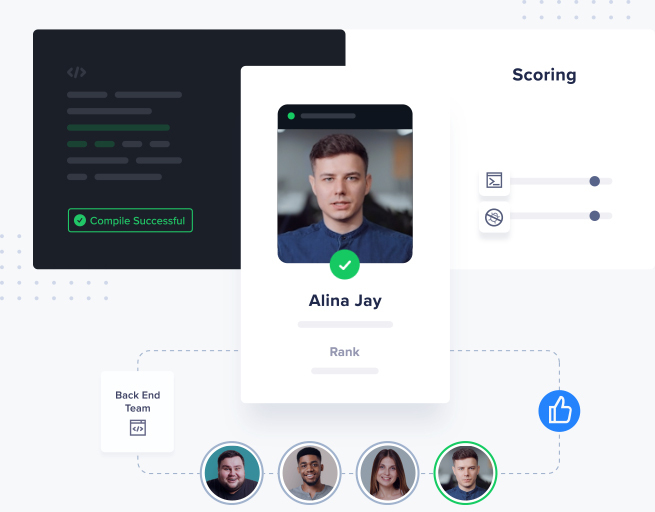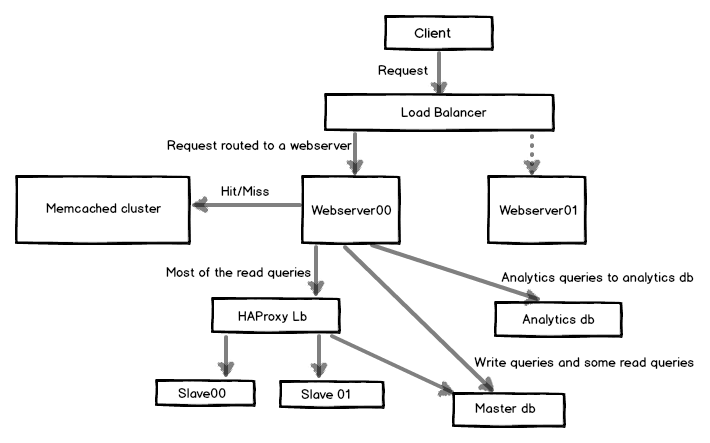Unlock skill-first hiring with HackerEarth today
Learn more
Scaling database with Django and HAProxy

MySQL – Primary data store
At HackerEarth, we use MySQL database as the primary data store. We have experimented with a few NoSQL databases on the way, but the results have been largely unsatisfactory. The distributed databases like MongoDB or CouchDB aren’t very scalable or stable. Right now, our status monitoring services use RethinkDB for storing the data in JSON format. That’s all about using NoSQL database for now.
With the growing amount of data and number of requests every second, it turns out that the database becomes a major bottleneck to scale the application dynamically. At this point if you are thinking that there are mythical (cloud) providers who can handle the growing need of your application, you couldn’t be more wrong. To make matters worse, you can’t spin a new database whenever you want to just like you do with your frontend servers. Achieving horizontal scalability at all levels requires massive re-architecture of the system while being completely transparent to the end user. This is what a part of our team has focused on in the last few months, resulting in high uptime and availability.
It was becoming difficult for the master (and only) MySQL database to handle the heavy load. We thought we will delay any scalability at this level till the single database could handle the load. We would work on other high priority tasks instead. But that wasn’t to be, and we experienced some down time. After that we did a rearchitecture of our application, sharded the database, wrote database routers and wrappers on top of django ORM, put HAProxy load balancer infront of the MySQL databases, and refactored our codebase to optimize it significantly.
The image below shows a part of the architecture we have at HackerEarth. Many other components have been omitted for simplicity.

Database slaves and router
The idea was to create read replicas and route the write queries to the master database and read queries to slave (read replica) databases. But that was not simple either. We couldn’t and wouldn’t want to route all the read queries to slaves. There were some read queries which couldn’t afford stale data, which comes as a part of database replication. Though stale data might be the order of just a few seconds, these small number of read queries couldn’t even afford that.
The first database router was simple:
class MasterSlaveRouter(object):
"""
Represents the router for database lookup.
"""
def __init__(self):
if settings.LOCAL:
self._SLAVES = []
else:
self._SLAVES = SLAVES
def db_for_read(self, model, **hints):
"""
Reads go to default for now.
"""
return 'default'
def db_for_write(self, model, **hints):
"""
Writes always go to default.
"""
return 'default'
def allow_relation(self, obj1, obj2, **hints):
"""
Relations between objects are allowed if both objects are
in the default/slave pool.
"""
db_list = ('default',)
for slave in zip(self._SLAVES):
db_list += slave
if obj1._state.db in db_list and obj2._state.db in db_list:
return True
return None
def allow_migrate(self, db, model):
return True
All the write and read queries go to the master database, which you might think is weird here. Instead, we wrote getfromslave(), filterfromslave(), getobjector404fromslave(), getlistor404fromslave(), etc. as part of django ORM in our custom managers to read from slave. So whenever we know we can read from slaves, we call one of these functions. This was a sacrifice made for those small number of read queries which couldn’t afford the stale data.
Custom database manager to fetch data from slave:
# proxy_slave_X is the HAProxy endpoint, which does load balancing
# over all the databases.
SLAVES = ['proxy_slave_1', 'proxy_slave_2']
def get_slave():
"""
Returns a slave randomly from the list.
"""
if settings.LOCAL:
db_list = []
else:
db_list = SLAVES
return random.choice(db_list)
class BaseManager(models.Manager):
# Wrappers to read from slave databases.
def get_from_slave(self, *args, **kwargs):
self._db = get_slave()
return super(BaseManager, self).get_query_set().get(*args, **kwargs)
def filter_from_slave(self, *args, **kwargs):
self._db = get_slave()
return super(BaseManager, self).get_query_set().filter(
*args, **kwargs).exclude(Q(hidden=True) | Q(trashed=True))
HAProxy for load balancing
Now there could me many slaves at a time. One option was to update the database configuration in settings whenever we added/removed a slave. But that was very cumbersome and inefficient. A better way was to put a HAProxy load balancer in front of all the databases and let it detect which one is up or down and route the read queries according to that. This would mean never editing the database configuration in our codebase — just what we wanted.
A snippet of /etc/haproxy/haproxy.cfg:
listen mysql *:3305
mode tcp
balance roundrobin
option mysql-check user haproxyuser
option log-health-checks
server db00 db00.xxxxx.yyyyyyyyyy:3306 check port 3306 inter 1000
server db01 db00.xxxxx.yyyyyyyyyy:3306 check port 3306 inter 1000
server db02 db00.xxxxx.yyyyyyyyyy:3306 check port 3306 inter 1000
The configuration for the slave in settings now looked like this:
DATABASES = {
'default': {
'ENGINE': 'django.db.backends.mysql',
'NAME': 'db_name',
'USER': 'username',
'PASSWORD': 'password',
'HOST': 'db00.xxxxx.yyyyyyyyyy',
'PORT': '3306',
},
'proxy_slave_1': {
'ENGINE': 'django.db.backends.mysql',
'NAME': 'db_name',
'USER': 'username',
'PASSWORD': 'password',
'HOST': '127.0.0.1',
'PORT': '3305',
},
'analytics': {
'ENGINE': 'django.db.backends.mysql',
'NAME': 'db_name',
'USER': 'username',
'PASSWORD': 'password',
'HOST': 'db-analytics.xxxxx.yyyyyyyyyy',
'PORT': '3306',
},
}
But there is a caveat here too. If you spin off a new server with the HAproxy configuration containing some endpoints which don’t exist, HAproxy will throw an error and it won’t start, making the slave useless. It turns out there is no easy solution to this, and haproxy.cfg should contain existing server endpoints while initializing. The solution then was to let the webserver update its HAproxy configuration from a central location whenever it starts. We wrote a simple script in fabric to do this. Besides, the webserver already used to update its binary when the spin off is from an old image.
Database sharding
Next, we sharded the database. We created another database — analytics. It stores all the computed data, and it forms a major part of read queries. All the queries to the analytics database are routed using the following router:
class AnalyticsRouter(object):
"""
Represents the router for analytics database lookup.
"""
def __init__(self):
if settings.LOCAL:
self._SLAVES = []
self._db = 'default'
else:
self._SLAVES = []
self._db = 'analytics'
def db_for_read(self, model, **hints):
"""
All reads go to analytics for now.
"""
if model._meta.app_label == 'analytics':
return self._db
else:
return None
def db_for_write(self, model, **hints):
"""
Writes always go to analytics.
"""
if model._meta.app_label == 'analytics':
return self._db
else:
return None
def allow_relation(self, obj1, obj2, **hints):
"""
Relations between objects are allowed if both objects are
in the default/slave pool.
"""
if obj1._meta.app_label == 'analytics' or \
obj2._meta.app_label == 'analytics':
return True
else:
return None
def allow_migrate(self, db, model):
if db == self._db:
return model._meta.app_label == 'analytics'
elif model._meta.app_label == 'analytics':
return False
else:
return None
To enable the two routers, we need to add them in our global settings:
DATABASE_ROUTERS = ['core.routers.AnalyticsRouter', 'core.routers.MasterSlaveRouter']
Here the order of routers is important. All the queries for analytics are routed to the analytics database and all the other queries are routed to the master database or their slaves according the nature of queries. For now, we have not put slaves for analytics database but as the usage grows that will be fairly straightforward to do.
At the end, we had an architecture where we could spin off new read replicas and route the queries fairly simply and had a high performance load-balancer in front of the databases. All this has resulted in a much higher uptime and stability in our application, and we could focus more on what we love to do — building products for programmers. We already had an automated deployment system in place, which made the experimentation easier and enabled us to test everything thoroughly. The refactoring and optimization that we did in codebase and architecture also reduced the server count by more than two times. This has been a huge win for us, and we are now focusing on rolling out exciting products in the next few weeks. Stay tuned!
I would love to know how others have solved similar problems. Do give suggestions and point out potential quirks.
P.S. You might be interested in The HackerEarth Data Challenge that we are running.
Follow me @vivekprakash. Write to me at vivek@hackerearth.com.
This post was originally written for the HackerEarth Engineering blog by Vivek Prakash.
Get advanced recruiting insights delivered every month
Related reads
The Impact of Talent Assessments on Reducing Employee Turnover
Organizations of all industries struggle with employee turnover. The high turnover rates cause increased hiring costs, lost productivity, and broken team dynamics. That’s…
Virtual Recruitment Events: A Complete Guide
Virtual hiring events are becoming vital for modern recruitment, and the hiring world is changing rapidly. As businesses embrace remote-first cultures and global…
The Role of Recruitment KPIs in Optimizing Your Talent Strategy
The competition for talent today is intense, and this makes it very important for organizations to get the right people on board. However,…
Interview as a Service – Optimizing Tech Hiring for Efficient Recruitment
Hiring trends are continuously evolving over the ages to keep pace with the latest technological advances. Hiring processes are being optimized almost every…
HR Scorecards: Using Metrics to Improve Hiring and Workforce Management
Hiring practices have changed significantly over the past 30 years. Technological advancements and changing workforce demographics have driven hirers to strike the right…
Why Recruiting Analytics is Critical for Hiring Success in 2024
In the current world, where the hiring process is ever-evolving, it has become crucial to make the right hiring decisions based on certain…














